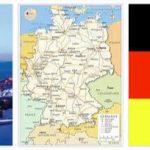On March 13, 1938, the territories of the Austrian republic became part of the German Reich as a Land. On the basis of the results of the Munich convention of 29 September 1938, the Sudetic territories also became part of the Reich. The following data update voice Germany for the territories belonging to the Reich first of these annexations.
Population. – According to the 1933 census the population of the Reich amounted to 66,029,000 residents, With an absolute increase, compared to the previous census (1925) of 2,848,741 people and an annual percentage increase of 0.56%. At the end of 1937 it was estimated that Germany had now reached 68,000,000 residents, that is how many it counted on the eve of the world war, on an area of 540,854 sq km. From the previous figures it is clear that, after the period of adjustment due to the world war, during which the demographic rhythm had decreased considerably, the increase in the population is once again remarkable. As for the natural movement of the German people, it should be remembered that, following the economic crisis, the birth rate, which had already contracted sharply in the immediate post-war period, it shrunk again alarmingly. To combat the birth rate, the government adopted a social re-education plan, inspired by ethical-racist concepts, to which it then linked various economic measures, aimed at facilitating the creation of new families (wedding loans) and encouraging the birth rate. Following this, there is a noticeable recovery in the number of births which from 14.7 ‰ in 1933 rises to 18 in 1934, to 18.9 in 1935, to 19.0 in 1936. Consequently, the natural increase resulted for the same years it also increased (7.00 ‰; 7.1; 7.2), but not in proportion to the births, since in the same period the mortality rate also increased (10.9 ‰; 11, 8; 11.8). As for confessions, at the 1933 census 62.7% of the population was Protestant, 32.5% Catholic, 0,
Economic conditions. – As you know, one of the most important parts of the German self-sufficiency plan is aimed at agriculture. Numerous laws, including the inalienability of properties from 7 to 125 ha., The constraint to the agricultural form, the obligatory conferment of the various products to government stockpiles, the imposition of sale prices, tend to place under the protection of the state the agriculture which is also encouraged by measures of various kinds. All this has brought a notable boost to the already advanced agriculture which, thanks to increasingly rational methods, tries to increase the quantity of products as much as possible (see table).
There is a significant increase in the production of potatoes, which from 400,771 q. in 1929 it reached 553,098 q. in 1937, and of wheat (44,269 q. in 1937 against 33,492 q. in 1929); while there is a slight decrease in oats and rye. Of equal importance to that of agriculture is the breeding of livestock for Germany, which, although intensive and rational, is insufficient to meet the needs of an ever-increasing population. In 1935 the livestock patrimony consisted of:
Of capital importance for the German economic life are the industrial activities that employ about 2/3 of the population with 1,903,420 establishments (cens. 1933). The world crisis has hit German industry hard, which, already very tried after the war, was just beginning to settle down. Following the crisis, the mining production of both coal decreased, which from 163,441 tons. in 1929 it drops to 136,856 in 1934, both of lignite (174,456 tons in 1929 against 137,274 in 1934). An even more serious contraction occurs in the production of iron which from 6374 tons. (1929) goes to 4343 tons. in 1934. But with 1935 there is a noticeable recovery, as can be seen from the attached table; recovery that also occurs in other industries, especially in textiles, metallurgy and chemistry.
It is also worth mentioning the attempt made by Germany to replace some raw materials that lack them with substitutes. The production of synthetic fuel is now very remarkable, obtained by hydrogenation from coal and lignite, which now supplies approximately one third of national consumption (760,000 tons). Indeed, it is expected in the near future that Germany will be able to completely free itself from the import of liquid fuels. The production of synthetic wool and cotton and rubber is also important.
According to localcollegeexplorer.com, the Germanic economic structure therefore hinges on the need to make a population of 68 million residents, Mainly dedicated to industries, live on a territory that is too small in proportion to the number of residents, of mediocre fertility and not rich in raw materials. The government has tried to compensate for this unfavorable situation with the aforementioned control measures on agriculture and industries. Efforts aimed at improving the economic situation are directed, as has been said, to food, for which the Germans always depended on foreign countries for considerable value, and to the raw materials necessary for industries. Food imports were gradually squeezed over the past decade. In fact, cereals show a very strong decrease, that from 652 million marks in 1925 to 42 million in 1935, meat (from 379 to 39), vegetable oils, eggs and dairy products, while legumes, fruit and fats are still imported in considerable quantities. It is estimated that today German agricultural production provides 85 per cent of the necessary provisions. This remarkable production, if we consider the not too favorable soil and climate conditions, has been achieved thanks to the use of increasingly rational cultivation systems. Along with the problem of food and what is vital to Germany’s economic policy is the supply necessary for its industries. The four-year plan tends to minimize Germany’s dependence on a number of raw materials, including mineral oils and products destined for production. textile industry. The world economic crisis and the rather high prices of German products have greatly reduced exports, while self-sufficient measures tend to reduce imports. Consequently, foreign trade from 29 billion in 1929 fell to less than 9 billion in 1935. Imports and exports in millions of marks are shown in the following table from which it appears that the trade balance after the 1934 deficit is new in surplus.
Overall Nazi economic policy has resulted in a sharp increase in German economic activity over the past 3 years, which however mainly concerns the domestic market.









